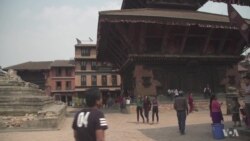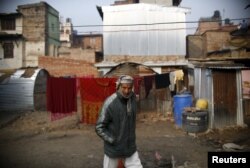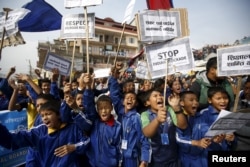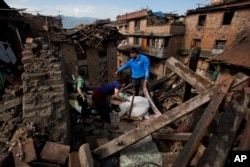Reconstruction has been painfully slow in Nepal although a year has passed since a deadly 7.8 earthquake (April 25) killed more than 9,000 people and flattened tens of thousands of homes.
Political tensions, a slow moving bureaucracy and crippling fuel shortages have made it harder for poor people in the remote mountain country to pick up the pieces of their lives.
Like thousands of Nepalese, Om Prashad, was working as a domestic servant in New Delhi when his life was turned upside down on hearing that his mountain home in the Arghakhanchi district had come crumbling down. He had built it just months before with his life savings.
He rushed back after borrowing money and slowly managed to reconstruct a small structure. He never returned to his job in India, hoping to get help from authorities who he heard had received billions of dollars in aid in the aftermath of the quake. But so far, the wait has been futile.
“Whatever the government promised, nothing has come. So many people are living in tents, or managing in open spaces, many have fallen sick,” he laments.
After passing a bitingly cold winter in temporary shelters under tarpaulin or plastic sheeting, an estimated four million people are facing the prospect of huddling under the same structures when monsoon rains lash the mountains. The rubble of broken homes still litters many mountain villages and roads to the remote parts of the country have yet to be rebuilt.
With hundreds of villages flattened, Nepal’s target is to rebuild half a million destroyed homes. But the official reconstruction campaign has yet to get off the ground.
Relief agencies working to help the earthquake victims have been frustrated with the snail’s pace of rehabilitation.
Politics over reconstruction
Many put the blame on the government’s decision to focus on promulgating a new constitution soon after the devastating quake. It not only sidetracked attention from the massive job of restoring lost homes and livelihoods, it fueled political tensions that led to violent protests by disgruntled ethnic groups.
A five-month border blockade by these groups choked supplies to the landlocked nation, leading to crippling shortages that virtually brought all activity to a standstill.
“That really did not help the reconstruction, so yes in hindsight, you might say maybe the government maybe should have chosen to give the first priority to reconstruction and then the constitution, but anyway they did not do it,” said the country director of Oxfam in Nepal, Cecilia Keizer, who worries about the speed of work. “For four-five months it was almost impossible, we had some goods blocked at the border, we could not get gas for cooking and it was the most cold season in the country. It was quite hard for us to deliver goods.”
A National Reconstruction Authority (NRA), put in charge of the job of rebuilding homes, was only established after months of delay in mid-December. International donors have pledged $4 billion, but Nepal is seeking $8 billion for a five-year program.
Sushil Gyawali, who heads the NRA, said surveys of most affected areas have been completed and the list of beneficiaries who will receive about $2,000 to reconstruct homes will be published soon. That may be small consolation for those awaiting a roof over their heads.
But Gyawali defends the organization, saying that while the pace of work may appear slow to the earthquake victims, the NRA only began work three months ago.
“If you compare this to any other country in the post disaster situation, you can say Nepalese are far ahead if you look at it from the perspective of the NRA establishment,” he said.
Seeking stability
Relief agencies that have struggled with the flip flops of government policy and bureaucracy hope the NRA will soon establish guidelines on rebuilding homes.
Dev Ratna Dhakhwa, secretary general of the Nepal Red Cross Society, said the agency’s plans to construct hundreds of houses was stalled because they needed approval from the government. “And then we were almost prepared earlier for making the shelters but then the government came up with a new authority and said that authority is responsible for giving permission,” said Dhakhwa. “But the good news is they have started distributing the first installment.”
Even when rebuilding gets underway, many challenges lie ahead: the tough mountain terrain, the remoteness of affected areas in the Himalayan region and the lack of connectivity in terms of good roads.
“Some places you have to drive for nine hours and then still walk for ten hours to reach the most remote area. In the beginning, we did a lot with helicopters but that is not affordable in the long run,” said Keizer of Oxfam.
However remote the place they maybe living in, the residents of one of the world’s poorest nations are unlikely to forget the day that changed the lives of millions of people forever.
As April 25 approaches, Om Prashad fervently sends up a prayer. “I hope such a black day never comes again. I will only remember this as the day that left behind so much suffering,” he said.










